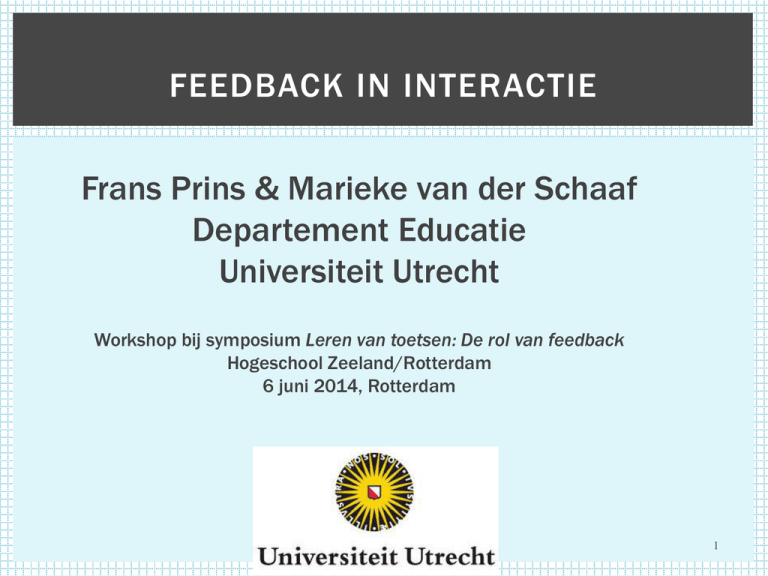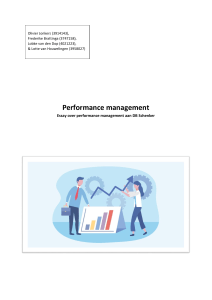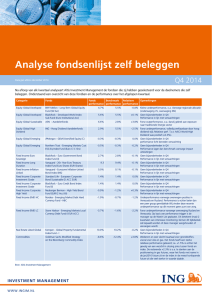FEEDBACK IN INTERACTIE Frans Prins
advertisement

FEEDBACK IN INTERACTIE Frans Prins & Marieke van der Schaaf Departement Educatie Universiteit Utrecht Workshop bij symposium Leren van toetsen: De rol van feedback Hogeschool Zeeland/Rotterdam 6 juni 2014, Rotterdam 1 INHOUD 1. Feedback: Waarom? Wat is het (niet)? 2. Perspectief van feedbackgever: typen feedback 3. Perspectief van de feedbackontvanger: zelf-regulatie 4. Feedback in interactie (Fii) 2 1. FEEDBACK: WAAROM, WAT IS HET (NIET)? 3 De definitie van feedback ‘‘actions taken by (an) external agent(s) to provide information regarding some aspect(s) of one’s task performance’’ (Kluger & DeNisi, 1996) “information provided by an agent (e.g., teacher, peer, book, parent, self, experience) regarding aspects of one’s performance or understanding” (Hattie & Timperley, 2007) “Specific information about the comparison between a trainees observed performance and a standard, given with the intent to improve the trainees performance (in clinical education)” (van de Ridder, Stokking, McGaghie, & Ten Cate, 2008) “information communicated to the learner that is intended to modify his or her thinking or behavior for the purpose of improving learning” (Shute, 2008) “information about the gap between actual performance level and the reference level, which is subsequently used to alter that gap” (Ramaprasad, 1983) “Information to fill the gap between a performance and what is aimed at to be performed” (cf. Sadler, 1989; 2010) GEMIDDELDE EFFECT-SIZES > 800 META - ANALYSES INVLOED OP LEERLING PRESTATIES ( H AT T I E , 2 0 0 9 ) I n fl u e n c e Feedback Students’ prior cognitive ability Instructional quality Instructional quantity Direct instruction Ac c e l e r a t i o n H o m e f a c to r s Re m e d i a t i o n / fe e d b a c k S t u d e n t s d i s p o s i t i o n to l e a r n C l a s s e nv i ro n m e n t Challenge of Goals B i l i n g u a l p ro g r a m s Pe e r t u to r i n g M a s te r y l e a r n i n g Te a c h e r i n - s e r v i c e e d u c a t i o n P a r e n t i nv o l v e m e n t H o m e w o rk Questioning N o . o f e f fe c t s 139 896 22 80 253 16 2 728 146 93 9 21 27 0 3 285 125 104 3 91 2 339 110 134 E f fe c t - S i z e 1.13 . 1.04 1.00 84 .82 .72 .67 .65 . 61 .56 .52 . 51 .50 .50 .49 .46 .43 . 41 5 2. DE FEEDBACKGEVER NIVEAUS VAN FEEDBACK (KLUGER & DENISI, 1996) Taak: hoe goed de taak is volbracht Proces: gericht op proces achterliggend aan taakvervulling Zelfregulatie: hoe de student het eigen handelen monitort en reguleert Zelf: praise op het niveau van de persoon van de student 7 KENMERKEN VAN EFFECTIEVE FEEDBACK Wiggins, 1997: -Timely -Specifiek -Begrijpelijk voor de ontvanger - Stelt de feedback ontvanger in staat om er naar te handelen ( refine, revise, practice, retr y) Ef fectieve feedback bezien in relatie tot in hoeverre studenten ermee gaan werken. Hoofdvragen t.a.v. feedback door studenten ( Hattie & Timperley, 2007): -Where am I going? (goals, feedup) -How am I going? (feedback) -Where to next? (feedfor ward) 8 T YPEN VAN FEEDBACK (SHUTE, 2008) Verification Knowledge of results or outcome, right/wrong, overall % correct. Tr y -again e.g., repeat-until-correct feedback Error-flagging Location of mistakes, error -flagging highlights errors in a solution, without giving correct answer. Elaborated Providing explanation why a specific response was correct, and allows learner to review part of the instruction. Topic-contingent Provides learner with information relating to the target topic currently being studied; e.g., re -teaching material. 9 T YPES OF FEEDBACK Worked Examples (SHUTE, 2008, CONTINUED) Provide worked examples and scoring rubrics as par t of learning. Response-contingent Feedback that focuses on the learner’s specific response. It may describe why the answer is wrong and why the correct answer is correct. Hints/cues/prompts Feedback that guides the learner in the right direction (e.g., strategic hint on what to do next or a worked example or demonstration). It avoids explicitly presenting the correct answer. Bugs/misconceptions Elaborated feedback that requires error analysis and diagnosis. It provides information about the learner’s specific errors or misconceptions (e.g., what is wrong and why). Informative tutoring Verification feedback , error-flagging, and strategic hints on how to proceed (correct answer not usually provided) 10 3. DE FEEDBACKONTVANGER Feedbackrollen feedback gever FEEDBACK ONT VANGER DE FEEDBACK ONTVANGER! …vaak over het hoofd gezien in feedback onderzoek en praktijk 13 PROBLEEM: STUDENT ONTEVREDENHEID (CARLESS, 2006) - Gebrek aan specifiek advies om te verbeteren - Moeilijk om te interpreteren - Een negatieve impact op self-perceptie en vertrouwen Dit geldt i.h.b voor studenten met weinig zelfregulatie vaardigheden; een mismatch kan ontstaan tussen beoogde feedback en feedback zoals gepercipieerd. ... Veroorzaakt door de docent, student of interactie tussen beide Soms wordt feedback niet eens herkend als feedback 14 EFFECTIEVE FEEDBACK VERGT DAT DE FEEDBACKONTVANGER: Een vergelijkbare norm voor performance heeft als de feedbackgever Voortdurend het niveau van performance vergelijkt met de norm Acties onderneemt om het gat tussen performance en norm te dichten. 15 4. FEEDBACK IN INTERACTIE THREE FEEDBACK MODELS (ASKEW & LODGE, 2000) Receptive-transmissive (feedback is a gift) Constructivist (feedback as a two -way process) Co-constructivist (feedback as a dialogue) 16 FASEN IN CONTINGENTIE ( VA N D E P O L E T A L . , 2 01 1 A DA P T E D F RO M R U I Z - P R I M O & F U R TA K , 2 0 07 ) 17 WAT NEEM JE MEE? . 18


